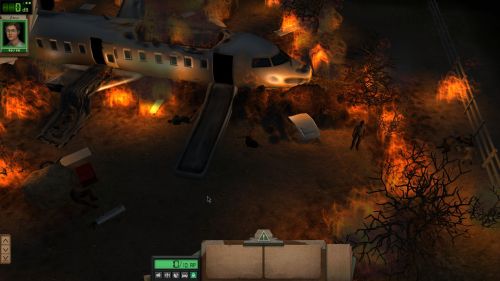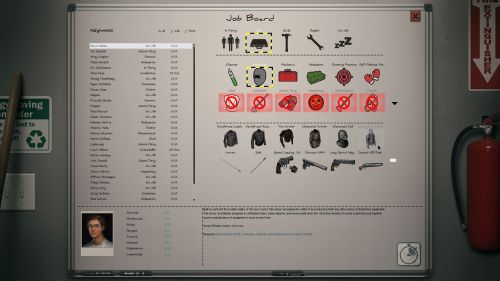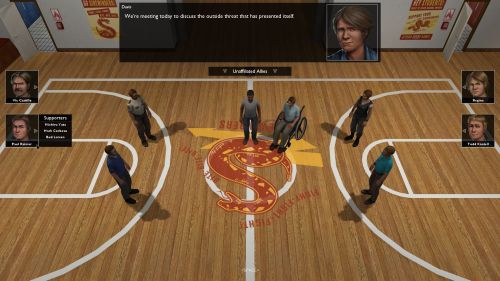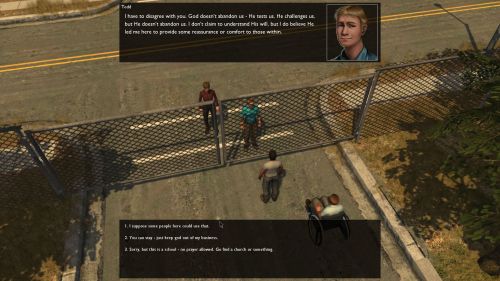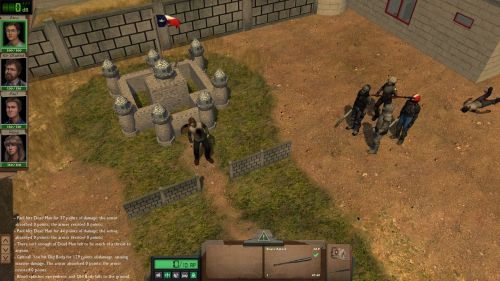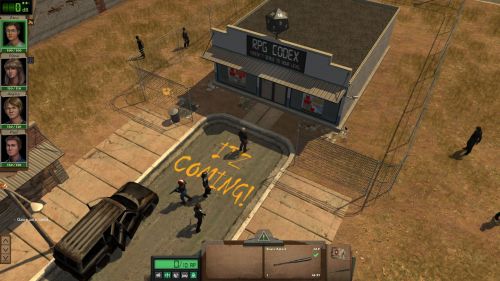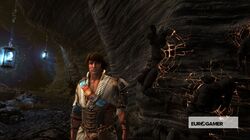RPG Codex Review: Dead State
RPG Codex Review: Dead State
Review - posted by Infinitron on Fri 6 February 2015, 21:30:45
Tags: Dead State; DoubleBear ProductionsMost of you should already be familiar with the story behind DoubleBear Productions' Dead State. Originally revealed all the way back in August 2009 and officially announced a year after that, the "zombie RPG" from Black Isle/Troika/Obsidian veteran Brian Mitsoda and his ex-Obsidianite wife Annie Mitsoda languished in vaporware status for years, until it was revived via Kickstarter in the heady days of 2012. Dead State was finally released in December 2014, now just one of many fish in the recovering oldschool RPG sea. Between that, its rather low fidelity 3D graphical presentation, some unfortunate Steam forum drama that led to a predictable backlash, and even some genuine post-release bugginess, Dead State seemed like it would quickly be left behind and forgotten.
But the Codex doesn't forget so easy. Two months ago, we hired Zombra, a rather mild and mellow fellow with a very appropriate name, to take Dead State for a spin and give it a fair appraisal. What he found out may surprise some of you. We proudly present...

Read the full article: RPG Codex Review: Dead State
But the Codex doesn't forget so easy. Two months ago, we hired Zombra, a rather mild and mellow fellow with a very appropriate name, to take Dead State for a spin and give it a fair appraisal. What he found out may surprise some of you. We proudly present...

Read the full article: RPG Codex Review: Dead State

That's Texas, all right.
Basic Overview
for those of you who don't know what you're reading about.
Dead State is an ambitious RPG that takes place during a zombie apocalypse. It is a "zombie game" that isn't really about zombies, but instead focuses on the conflicts and tribulations of survivors during the breakdown of society. The game is brought to us by DoubleBear Productions, led by Brian Mitsoda, best known for his writing and design work on the beloved and brilliant Vampire: the Masquerade – Bloodlines.
The story centers on the leader of a DIY survival fortress in a school building, and a few dozen souls who come to shelter there. Gameplay consists of a nice mix of exploration and scavenging, a good deal of turn-based combat against zombies and enemy survivors, base management, and dialogue with allies.
On paper, this all sounds great, but balancing these diverse elements must have been tricky. Does the game succeed? I found out over the course of an enjoyable five weeks.
Note: this review is based on version 1.0.0.0135 of the game, which used the patch released in late December 2014. At least one more patch has been released since then.
UI
My first impressions of the controls and feedback left me frustrated. For example, the camera controls feel unnecessarily restrictive, prohibiting the vertical tilt up to a top-down view or down to over-the-shoulder for no evident reason.
Inventory and management screens are very clean and handle well, but the controls themselves are often unintuitive. Certain commands can only be issued with the mouse, using a weird right click cursor icon rotation, while other commands have convenient hotkeys. It's common that a given screen will not have relevant information, entailing a lot of flipping back and forth – for example, you can't look at an ally's stats when choosing their equipment, which ended up wasting a lot of time in my playthrough. The game clock can only be accessed from the world map screen, which is only accessible on map exit grids, making it needlessly difficult to plan ahead. And so forth.
The text area at the bottom of the screen prints everything in white, with no translucent window or drop shadow, which can make text difficult to read on the sunny desert backgrounds.
All of this was annoying at first, and I frequently felt held back by the various inefficiencies, but functionality is smooth, so once I learned where everything is, making it work wasn't a big problem. Reading the manual helped a lot.
RPG Elements
Character creation is simple but satisfying, using a straightforward point buy system. Attributes advance on a linear scale (1 point spent = 1 attribute point) and skills advance on a progressive scale whereby each rank is costlier than the last. There is no direct feedback on attributes during creation, so it's hard to guess whether, for example, a 3 Strength is strong or weak, but the manual has charts in the back which detail some of the game effects. Figure it out.
Character advancement is fun. There are no experience points or arbitrary levels. Instead, skill points are awarded directly for different activities, including the completion of missions given by allies, supply gathering, decrypting electronic journals found in the field, and distributing luxury items.
Buying up skills not only increases their efficiency, but also allows the periodic selection of special abilities (Perks). An expert mechanic might choose between building a solar generator to reduce fuel consumption in the shelter and increasing the engine efficiency of the team's scavenging vehicle. An experienced survivalist can pick either increased travel speed on the main map or a higher food yield from shelter gardens. The abilities are dramatic in their effects, making these choices meaningful and enjoyable.
Shelter allies also develop their stats and skills over time. The player has no direct control over their point allocation, but most allies have special dialogue events in which you can encourage them to focus on particular abilities.
By the end of the game, I had enough skill points to max out 6 of the 8 skills, which was way too much. While the game is long and it's nice to have a feeling of continued character progress, this could easily be maintained with skill points awarded at half the current rate, or even less.
Graphics and Sound
No one expects a AAA eyegasm here, but I think the art deserves a solid brofist. The graphics are clean, communicative, and stylish.
If you are the type of player who asks about graphics first and gameplay second, this may not be the game for you, but I was surprised at how good it looks. The environments in particular are very inviting, all hand-built with nice attention to detail. From the cracks in the sidewalk to the graffiti on the walls to the garbage bags on the curb, there is a very strong and appreciated sense of place, yet there is not so much detail as to overwhelm me and make me tune it out. For me, this is the sweet spot.
I could see how some might say that the environments are kind of bland and samey, but speaking as someone who has visited small-town Texas, I really liked how well the vibe of that area was captured. Lead artist Oscar Velzi did a lot of virtual commuting to Texas via Google Maps for visual research, and it shows. It'd be valid to complain that the relentlessness of the flat, sun-baked plains is depressing after a while, but I think it makes for a very strong atmosphere for this type of story. It's supposed to be desolate.
Day and night scale beautifully. Enter a strip mall parking lot at 8PM and your team will cast long shadows. Stay out after sundown and the maps get dark. It's a great touch, and adds some welcome visual variety – at least, until you learn that it's smart to be back at the shelter by evening.
Equipped items such as bulletproof vests and sledgehammers appear graphically on characters in the game field, and look cool. It’s fun to watch your team of normal jeans-and-t-shirt citizens evolve into badass, leather-clad, welding-mask-wearing apocalypse killers, and again into modern armored soldiers.
As for performance, I ran at highest settings on a GPU a few years old with a framerate at a solid 60 per second. This is not a game intended to challenge your system or dazzle you with latest-gen effects. Unless you have a super old or weird configuration they didn't test for, framerate is not going to be a problem.
The music is good. I'd say it does its job, providing a contemplative, somewhat creepy ambience. Composer Leif Chappelle merges the omnipresent, abyssal drone of an empty world with occasional, tentative piano, guitar, or chimes, which to me represent the struggling voices of the few who are still hanging on. The instruments only become confident and melodic in "safe" places such as behind the walls of the shelter, and turn harsh and percussive during combat sequences. Music is dynamic – depending on the number of active enemies in combat, it changes its intensity. Nice touch. Additionally, there are different tracks for different moods at the shelter - an ally angry with a decision you made will yell at you to a different hook than the one you’ll hear when a friend talks about their scary nightmares.
You will hear some tracks over and over again – frankly, I got pretty sick of that acoustic guitar line when coming home to the shelter – but there are also a few that only play rarely or even just once, which revitalized my auditory interest several times throughout the long game.
Sound effects are sparse but not especially lacking. Guns sound like guns, people grunt when injured, zombies moan. The only sounds that bothered me were the little barks for combat start. It's off-putting to hear a generic voice mutter, "Shit!" when there is no other voice acting in the game. Either do more or take it out.
Last note on sound – the "clonk" of my baseball bat into a zombie skull never gets old.
CombatWe're looking at a standard turn-based action point system here. It's not Jagged Alliance, but it works well for a game never intended to be a hardcore combat sim. I found it complicated enough to keep me making little decisions here and there, while simple enough to keep things moving. There is a lot of combat in the game, so in terms of complexity I think they again hit the sweet spot here.
Every weapon has a straightforward basic attack that usually comes with a chance to inflict a status effect, such as knockdown or bleeding, depending on the weapon. Additionally, each weapon enables one or more special attack types, with varying AP costs, which generally focus on these effects. For example, a baseball bat might have a 15% chance to inflict the Dizzy status with a basic strike, but the Stagger maneuver comes with 100% chance of inflicting Dizzy at the cost of reduced damage and increased AP expenditure; and then there's Push, that also has reduced damage, but guarantees knocking the target back a square (often useful in tight quarters). A normal hit with a Machete might apply the Bleeding effect to a living target, but the Slash maneuver increases this chance to 100%; a Machete user can also try for a Critical Strike, with reduced chance to hit but greatly increased damage. Many attack types are shared by multiple weapons; for example, both the Sledgehammer and the Makeshift Pike allow the Knockdown maneuver. There are no tooltips for attack types in game (yet), but once again the manual comes through with full descriptions.
One cool aspect of Dead State's combat is its unique noise system. The more noise you make in the game, whether with firearms, heavy melee attacks, or bashing in a locked door with a crowbar, the greater the likelihood that zombies will be drawn to the area. Firing a gun is a great way to disable an enemy, but chances are that more undead will appear as a result. It's also possible to turn this to your advantage: when fighting looters and bandits, if you're positioned well, you can essentially summon zombies to harry your opponents! Of course, such a strategy is risky, and bringing in more targets does make combat drag out longer. Annoyingly, there is no way to generate noise intentionally without the use of special items: your characters cannot do something as simple as yell or pound on a wall to attract attention.
For me, combat was challenging enough to be scary and nerve-wracking at first. There were a couple of wonderful, tense hours during which I avoided contact with zombies whenever I could. With no XP reward for killing them, all they represented was a chance of injury, and facing more than one at a time seemed flatly suicidal. Sadly, this feeling did not last long, and slaughtering zombies soon became routine and even a dull chore in highly populated zones. Available armor is just so powerful so early in the game that zombie attacks become a non-issue far too quickly. Most damningly, even when zombies do inflict damage, there is no chance of infection unless the victim has been knocked out first. Throughout the game, not a single zombie infected a member of my party in combat. Not once. This is a major problem, as no story in this genre is complete without the horror of seeing a healthy character bitten and dealing with the complications.
Moving on from zombies, gun-wielding survivors are much more dangerous and require more attention to defeat. Run-of-the-mill scavengers and raiders are easy meat for anyone experienced with these types of games, but there are a number of set-piece encounters with stronger combatants that woke me up and made me try. These got even more interesting when the noise brought zombies into the mix, or when I ran into groups of survivors already fighting each other. Three-way and even four-way battles show off this game's combat at its best. I even stumbled into a five-way skirmish at one point! And at the close of the game, the ending I chose culminated in a wonderful, tough as nails final assault.
Non-Combat Gameplay
There is a lot to cover here as there are many different gameplay elements in Dead State.
** Exploration and scavenging. Most of your time is going to be spent traveling to new maps and sifting through them for food and supplies. Overall this is pretty fun, particularly if you have a collector type mentality: it feels rewarding to run around, clicking on shelves, refrigerators, and dead bodies, and loading up whatever you find. Most food and luxuries are nonrenewable resources, and the shelter has a constant need. Gasoline is required to keep the electric generator running. Building materials for the shelter are also essential, especially at the beginning of the game, and there's also an obvious demand for weapons, armor, and ammunition. This all provides the player a strong motivation to scavenge.
The problem: the game is very generous in providing everything you need. Despite all the looters one encounters, there are still food and luxury items lying around everywhere. Although the player is certainly motivated to go scavenging for more, it never feels desperate, and I was never tempted to call for rationing or the eating of dead rats and insects. This is a big disappointment for a game of this type.
Despite this, there's a nice curve to the loot. At first you will want to scavenge absolutely everything, but by the end of the game you will be picking and choosing. In true RPG fashion, it's a good feeling to become powerful enough that you end up throwing away stuff that was amazing treasure at the start.
Another resource you must manage is antibiotics for shelter personnel infected with the zombie virus. At the time of this writing, however, the infection is a complete non-issue. Although there are allies who are infected before you ever meet them, zombies never infected my people in combat, the infection never spreads in the shelter, and I always had tons of antibiotics anyway. I was really hoping for the Crisis Event where I ran out of medicine or the infection started to spread – you just can't have a story like this without dealing with this problem - but managing the virus is stupidly easy.
When exploring, the landscape is often scattered with zombies. If you can sneak up behind one, it can be a simple matter to kill it with one quiet, well-placed blow. Depending on their relative locations and facings, this activity becomes almost like a procedural puzzle game. Which zombie do you kill first so that the others don't see? This approach allows the player to "clear-cut" areas safely, and without the tedium of facing the horde in slow-paced turn-based fights.
Of course, there are also zombie-dense areas where this approach is not possible, and there is always a chance you will meet other survivors. Every zone is hand-designed, and I was impressed with the variety of enemy placements and the challenge of approaching each new situation. You'd think that zombies are just zombies, but there's a big difference between a dozen zombies loitering around a gas station, and a dozen zombies clumped at the front door to a convenience store with looters inside.
The fog of war system overall works great. While you can see the whole map at all times, enemies and NPCs only appear on the map if your characters are within range and line of sight. However, there is one major annoyance with sight lines. When exploring, there's no way to look into a building through windows or even open doorways, as the roof is always displayed if no allies are inside. Usually, the only way to see inside a building is to walk in. This leads to some unfortunate surprises, and not in a good gameplay way.
Even when scavenging isn't especially dangerous (see Combat), the tension can still be fun. Will there be zombies in this house? Looters, maybe? Or will it be empty? This is especially true if the game is played in brief sessions instead of marathons.
Area encounters are disappointingly static. If you clear an area of zombies, you can return for loot a week later and no new enemies will be on the scene. However, there are random encounters on the main map, which keep things at least a little unpredictable.
Wonderfully, the world does not always wait for you. Potential allies can only survive for so long on their own. Sometimes I found the dead bodies of named NPCs while exploring later in the game.
** Base and personnel management. As the leader of the shelter, it falls to you to make sure that everyone is fed and happy, and that the building is secure from attack by zombies and looters. This means that in addition to selecting a team and leading the scavenging expeditions personally, it is your responsibility to allocate available labor to various other jobs and duties, from building fortifications and shelter upgrades, to standing guard, to synthesizing antibiotics. Even taking a day off to watch DVDs on the couch is a "job" you can assign to boost the morale of a stressed out ally. This is all done through a very simple and easy to use "Job Board" interface. (I wish the Board would stop reordering my worker list, though. Glitch!)
At first, assigning jobs seems bare bones and without much potential, as you don’t have much choice of assignments with just a few people available, but as more survivors join the shelter, it gets much more fun and involved.
The decision-making process in assigning and equipping your scavenging party and choosing a travel mode (foot, horse, or car) is interesting, logical, and relevant. You need to balance such factors as carrying capacity, fuel consumption, time spent traveling to and from the shelter, mechanical capability (for quietly opening locked doors), medical capability, survival skills (for finding foragable food), melee combat capability, ranged combat capability, damage resistance vs. zombies and melee, and damage resistance vs. gunfire. Phew! A group of unarmored marksmen on horseback will perform differently in the field than a team of heavily armored sledgehammer specialists driving the car, or a more well-rounded team built to handle whatever comes up. On top of that, you need to consider the shelter’s noncombat labor needs – you can’t take your top mechanic into the field if she’s needed that day to repair the refrigerator. Lastly, there’s always the possibility that an ally will be unavailable on a given day due to illness or other personal reasons. If your best sniper gets sick, you'll have to pick someone else to cover your back for a while. Coping with all of these decisions made me feel very involved with everyone in the shelter.
** Personal dialogues and shelter Crisis Events. Of course, there are occasional dialogues during encounters in the field, with fight/flight/befriend type options and some information gathering. What you might not expect is the battery of dialogues that occurs in the safety of the shelter each morning. The people living at the school often drop by your "office" for various reasons - sometimes to let you know that they’re too sick to work, or even just to say hi and talk the current situation over. Other times, they may bring concerns about other characters, such as a daughter worried about her parent being endangered in the field, or a victim of harassment coming to you for help.
There are also many confrontations between allies to be found elsewhere in the shelter during this phase, such as someone accusing someone else of cheating at cards, or picking a fight with them, or even asking them on a date.
You are given the opportunity to participate in these conversations or merely observe, and the outcomes of all of these incidents may affect individual morale, shelter morale, and/or character attitudes towards your PC or each other. Sometimes, speaking to an ally can even alter the course of their development – discussing the need for security may cause an ally to focus on their shooting abilities, for example, while emphasizing the need for food may inspire them to become a better farmer.
Outsiders can also come to you during this phase – not everyone is waiting out in the world for you to come find them. Several conversations occur through the shelter fence, mostly from people requesting sanctuary or other aid.
Enjoyably, in these interactions and throughout the game, using dialogue options unlocked by the Leadership and Negotiation skills is not always a no-brainer. A character who respects strength might not appreciate the smooth tongue of Negotiation, and the authoritative force of Leadership might alienate a more sensitive ally. Then again, a headstrong person might be better persuaded than ordered about ... and so forth. The game encourages you to actually read your options instead of just lunging for the one associated with a skill.
Then there are the "big" conversations, known as Crisis Events. These occur when a major decision needs to be made – for example, if an ally is caught committing a crime, what should be done with him? In these cases, you and the "sub-leaders" meet in the gymnasium to talk it out. Sub-leaders are characters who command respect in the shelter and represent the opinions of their supporters, sort of like what politicians are supposed to be. The situation is laid out, the sub-leaders make their recommendations, and then you make a decision.
Depending on the results of your decision, shelter morale may be affected, and members may gain or lose respect for you. In practice, I found that almost every decision I made gained universal acclaim, because even those who didn’t agree with me respected me enough to give me a "pass" for going against their wishes. You can also attempt to "buy" support from sub-leaders with bribes and persuasion, but I never found this to be necessary. I think this is because I was able to keep group and individual morale so high all the time.
Despite the lack of morale-related repercussions, Crisis Events are fun. They are strong, heavy punctuation to the constant lighter chatter of the less important conversations, and the decisions themselves can have substantial impact on the situation in the shelter.
Pacing and Player Motivation
To begin with, the game takes many hours to find its stride. The first several game days with just a few bland allies at the shelter aren't exactly bad, but things only start to pop when some more extreme personalities appear and they start coming to you with problems every morning. I didn't really know what I was missing at the beginning, but in retrospect, it should really pick up much sooner.
Dead State is a LONG game. There is a ton to do and you'll find many, many locations to explore. Since the explore/loot/haul stuff home mechanics can get repetitive, I don't recommend this as a game to sit down and marathon in a weekend, but it seems great for the type of game to dip into for a few hours a couple times a week. If you try to cram it all at once, you may lose interest when you hit the Mid-Game Slump. Read on.
The Mid-Game Slump: although the day-to-day stories are interesting and small problems arise frequently, there are few to no overarching goals other than to make it through each day and generally try to improve things. You essentially clock in each morning, deal with people's complaints, try to get them all fed, and then clock out and go to bed – repeat forever. I'm not saying that every game needs an evil wizard that must be slain, but once the shelter has things under control, it's hard to be inspired every day to go look for more cans of food. The "To Do List" (mission log) might be helpful with this, but mine bugged out and stopped working right as I hit the Slump. (Coincidence?)
One nice way to invigorate gameplay is to crank the animation speed in the options menu. This speeds up everything, including noncombat movement speed! The game acquires a jarring Benny Hill effect at the highest speeds, but the plodding routine of sweeping maps is greatly enlivened. I didn't increase the speed until many hours into the game, because I felt it spoiled the quiet atmosphere, but once I did, I became much more engaged. If you hit the Mid-Game Slump and speed is still at default, turning it up will help.
Writing, Story, and Atmosphere
I hate to say it, but Dead State's writing starts off on the wrong foot, and stays on that foot too long. The game begins at the site of a plane crash, with a disembodied voice yelling at you to kill a guy standing there with his back to you ... and you do it. The actual dialogue isn't bad, but the presentation is disorienting. The player knows what's going on, but from the character's point of view, it makes very little sense, and not in a good "dramatic mystery" way.
We see clumps of zombies eating corpses, but I only know that from playing zombie games before. To the PC, it just looks like groups of people gathering around something on the ground. There's no Resident Evil introduction to the undead, no Dead Rising glimpses of terrifying behavior to set up the horror to come; I am simply told that there's a virus turning people into flesh-eating monsters. Uh, okay.
Soon, the player character wakes up injured on a cot, in a basement with a few survivors, and within minutes he is appointed President of the shelter and charged with leading a scavenging expedition. What? It seems that my character is a "chosen one", which is okay, but there's not even a handwaving justification for it. I can rationalize that the other characters are having a hard time keeping their heads, so I need to step up, but without this being made explicit, my assumption of leadership is very forced.
In comparing all of this to the marvelous tutorial section of Vampire: Bloodlines, which introduced me smoothly and entertainingly into its bizarre world, I was disappointed at Dead State's prologue.
Fortunately, the writing quality picks up sharply after the beginning. Exploring the school and talking with the people there helps paint the apocalyptic picture I was looking for. The game would definitely benefit from the great voice acting of a title like Bloodlines, but the writing keeps its feet at least adequately, and often admirably, in silence.
That first group you meet in the basement is fairly bland, but once the concussed guy from the plane crash wakes up, personalities start getting seriously lively and diverse. One might complain (not without some justice) that some characters are too silly or one-note, but I found all the dialogue worth reading. The character writing ranges from adequate to beautifully nuanced. Everyone you meet is distinctive in some way, and even with 30+ allies packed into the shelter, between the writing and the portrait art, I never once got anyone mixed up or forgot how I met each one. This is quite a feat for a game with so many characters.
There have been some questions about random character placement or procedural generation of party members. Due to the nature of the text, this would be impossible without literally rewriting the entire game several times over. Imagine playing Bloodlines and placing the NPCs randomly - it wouldn't make any sense. What is Chunk doing running Vesuvius? Dead State's characters don't all have Bloodlines depth, but they are far more than random bags of stats. Nevertheless, despite placement being static, there could be some decent replay value here, as finding all survivors in your first playthrough seems very unlikely (I found about 85% of the ally characters in my game). I also noticed that there is sometimes (always?) a random element to the "smaller" conversations - I reloaded a game once and saw a different argument than the one that had played previously, and a different person reported in too sick to work - so there is at least some mixing and matching happening behind the scenes, and probably more that I didn't notice.
As for the writing of the overall story, I liked it. I cared about the characters, I wanted to know what was going on, I wanted to know how it was all going to end up, I looked forward to meeting each new survivor and perhaps getting another sliver of information.
This is also a good time to mention the "Data Items" that you can discover when scavenging. Damaged computers, cell phones, and so forth can yield Data Items, which you can decrypt back at base using a password hacking anagram system. Doing so yields various fragments of communication from survivors in other areas, from emails and final letters written to loved ones to BBS posts and posterity articles. There is a lot of great stuff to read here, and a ton of background on how the country is dealing with the virus situation, from many different points of view.
Several characters have their own arcs as well. Not everyone is content or even able to just stand in their one spot indefinitely. They won't all be there forever. It feels great when allies are lost, particularly to these scripted story elements. Human frailty and loss are major themes in the apocalypse genre in general and the zombie genre in particular.
One of Mitsoda's stated goals in making Dead State was to look back to the George Romero roots of the zombie story. Nowadays, zombie games are often splatterhouse shoot-em-ups with little or no focus on the people trying to survive. I haven't watched a Romero film for a while, but if DoubleBear was trying to create a drama that made me care more about the characters in it than the gory special effects, they succeeded. Overall, though, Dead State just isn't pessimistic enough. Moment to moment, there's not enough dread of death, not enough sense of things falling apart.
Lastly, a writing nitpick, but one I can't let go without mentioning. In the early game and again at the ending, I saw frequent usage of "?!" as punctuation. Dude – don't do that.
Technical
Let's get something straight. There is a lot of talk out there about how Dead State is a buggy mess, nothing works, it's a crime that it was ever released from Early Access, etc. The truth is: everybody saying this is full of shit. There are a few serious bugs, some scripting errors, and animation glitches, but the game is completely playable and enjoyable from beginning to end. The bugs in Dead State would only be a dealbreaker for a spoiled child. It's just not a big deal.
That said, let's talk about some of the issues I did have.
The only truly catastrophic bug I experienced was a recurring engine crash due to some kind of shader error. CTDs are bad. I put up with this for a while, hoping for a patch, then actually read the error message, saw the word "shader", and tried turning my shader setting down to minimum. Never had that crash again, and honestly I didn't notice any difference in the graphics. Maybe you would. I don't know. So much for gamebreakers.
Scripting problems. I noticed one or two events that occurred out of order. There was one storyline in which the game failed to recognize a decision I'd made, and another in which an upgrade alluded to by an ally never appeared on the Job Board. Except for the last one, none of these really got my goat, though obviously it would be better if all the mission scripting worked perfectly. I'm sure there are more scripting errors out there that I didn't see.
The To Do List. The game's mission log seems to have a lot of problems, with certain things not being checked off properly and other things not appearing on the list after character dialogue should trigger them. It worked fine for the first third or so of the game and then wigged out on me to the point at which I stopped consulting it completely. This is a serious problem as the List is a major motivating force in a game that can drag.
I also experienced a handful of minor cosmetic glitches. I won't bother detailing them, but for the sake of completeness, you should know that they're there.
On the positive side, load times are lightning fast, and again the graphics engine seems well optimized. It's hard to make a list of technical things that worked especially well. For the most part, the game ran great for me.
Overall Balance
Here and there in the above sections I've mentioned how easy and permissive Dead State is in places. Unfortunately, these small failures to challenge the player compound to make the game as a whole a toothless cakewalk. It could be so much better if it just had something to make it more challenging, even in just one or two aspects. If the save mechanics were tougher and loot were scarce, the easy combat might be okay. If the combat were scary and hard, abundant loot might be okay. Even if the shelter allies gave the player such a hard time that the school ended up tearing itself apart, the rest might be okay. The game is just too soft on the player in every way. After the first few days, the only time I felt any pressure at all was during combats with heavily armed human opponents, and even these became almost routine with heavy ballistic armor.
I wanted to worry about people starving. I wanted to run out of antibiotics. I wanted allies to get angry about decisions I'd made, to the point of leaving the shelter. I wanted to turn people away because we didn't have enough food. I wanted a nervous ally to come to me and admit that they'd been infected in the field and hid it as long as they could. I wanted to be the only one to make it back after taking a scavenging team to the big hospital. None of this was possible, just because of the numbers.
I've thought about it a lot. This review isn't the right place for it, but in the comment thread below I will venture my armchair design suggestions to better balance the game.
tl;dr: Summary and Final Thoughts
UI: Does the job but is inefficient and wasteful.
RPG Elements: Simple, but solid and fun.
Graphics and Sound: Not AAA but surprisingly good.
Combat: Well-designed. Too easy.
Non-Combat Gameplay: Lots to do. Ambitious and compelling game structure. Fun!
Pacing and Player Motivation: Long game. Bogs down in the middle.
Writing, Story, and Atmosphere: Stumbles at the beginning. Ranges from fair to excellent after that.
Technical: Some bugs, but nothing gamebreaking.
Overall Balance: Crap.
Bottom line! Should you buy it? I want to say yes to immediately put money in DoubleBear's coffers. The honest answer: wait for the balance patch that makes this the survival game with hard decisions it was meant to be. Then pay full price – it'll be worth it.
At the end of the day, Dead State is not the perfect RPG – yet – but there is a lot to love about it and a lot to be impressed by. The good news is that the foundation of the game is sound. Individual gameplay elements function well, and if rebalanced properly, this could become a truly historic title.






